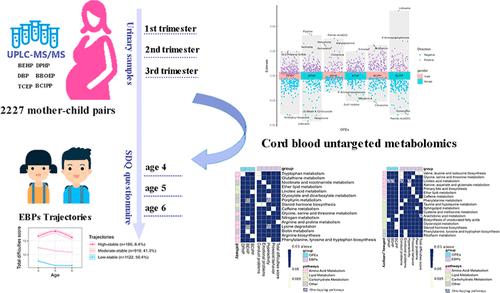Prenatal OPEs Trimester- and Sex-Specifically Linked to Trajectories of Preschoolers’ Emotional and Behavioral Problems: Insights from Cord Blood Metabolomics
IF 11.3
1区 环境科学与生态学
Q1 ENGINEERING, ENVIRONMENTAL
引用次数: 0
Abstract
Organophosphate esters (OPEs) are neurotoxic, yet their impact on children’s emotional and behavioral problems (EBPs) trajectories remains understudied, and biological mechanisms are unclear. In a prospective cohort of 2227 mother–child pairs, maternal urinary concentrations of the tris(2-chloroethyl) phosphate (TCEP) and six OPE metabolites were measured across three trimesters. EBPs were assessed at ages 4–6 using the Strengths and Difficulties Questionnaire, with trajectories modeled via latent class growth analysis. The results showed that bis (2-ethylhexyl) phosphate (BEHP) was associated with elevated hyperactivity and total difficulties score trajectories in both sexes. In girls, diphenyl phosphate (DPHP) was positively associated with higher trajectories of emotional problems (OR = 1.39) and bis(1-chloro-2-propyl) phosphate (BCIPP) was associated with higher trajectories of total difficulties score (OR = 1.25), prosocial behavior (OR = 1.45), hyperactivity (OR = 1.80) and peer problems (OR = 1.45). BBOEP showed negative associations with several EBPs trajectories in boys. The second-to-third trimester emerged as a sensitive window. No mixture effects were observed. Exploratory metabolomics analysis of cord blood (p < 0.05) linked DPHP, BEHP and BCIPP to metabolic disturbance, especially lipid-related pathways. In girls, several polyunsaturated fatty acid (PUFA) pathways─linoleic acid, arachidonic acid, and α-linolenic acid metabolism─were key mediators of OPE-induced EBPs trajectories impairments. This study highlights sex- and trimester-specific neurotoxicity of OPEs and provides mechanistic insight from cord blood metabolomics.

产前OPEs与学龄前儿童情绪和行为问题的轨迹相关:来自脐带血代谢组学的见解
有机磷酸酯(OPEs)具有神经毒性,但其对儿童情绪和行为问题(ebp)轨迹的影响仍未得到充分研究,其生物学机制也不清楚。在一项包含2227对母婴的前瞻性队列研究中,研究人员在妊娠三个月期间测量了母体尿液中三氯乙基磷酸(TCEP)和六种OPE代谢物的浓度。使用优势和困难问卷对4-6岁的ebp进行评估,并通过潜在类别增长分析建模轨迹。结果显示,双(2-乙基己基)磷酸(BEHP)与两性多动症和总困难评分轨迹升高有关。在女孩中,磷酸二苯酯(DPHP)与较高的情绪问题轨迹呈正相关(OR = 1.39),二氯-2-丙基磷酸(BCIPP)与较高的总困难评分(OR = 1.25)、亲社会行为(OR = 1.45)、多动(OR = 1.80)和同伴问题(OR = 1.45)轨迹相关。在男孩中,BBOEP与几种ebp轨迹呈负相关。第二到第三个月是一个敏感的窗口期。未观察到混合效应。脐带血的探索性代谢组学分析(p < 0.05)将DPHP, BEHP和BCIPP与代谢紊乱,特别是脂质相关途径联系起来。在女孩中,几种多不饱和脂肪酸(PUFA)途径──亚油酸、花生四烯酸和α-亚麻酸代谢──是ope诱导的ebp轨迹损伤的关键介质。这项研究强调了OPEs的性别和妊娠特异性神经毒性,并提供了脐带血代谢组学的机制见解。
本文章由计算机程序翻译,如有差异,请以英文原文为准。
求助全文
约1分钟内获得全文
求助全文
来源期刊

环境科学与技术
环境科学-工程:环境
CiteScore
17.50
自引率
9.60%
发文量
12359
审稿时长
2.8 months
期刊介绍:
Environmental Science & Technology (ES&T) is a co-sponsored academic and technical magazine by the Hubei Provincial Environmental Protection Bureau and the Hubei Provincial Academy of Environmental Sciences.
Environmental Science & Technology (ES&T) holds the status of Chinese core journals, scientific papers source journals of China, Chinese Science Citation Database source journals, and Chinese Academic Journal Comprehensive Evaluation Database source journals. This publication focuses on the academic field of environmental protection, featuring articles related to environmental protection and technical advancements.
 求助内容:
求助内容: 应助结果提醒方式:
应助结果提醒方式:


